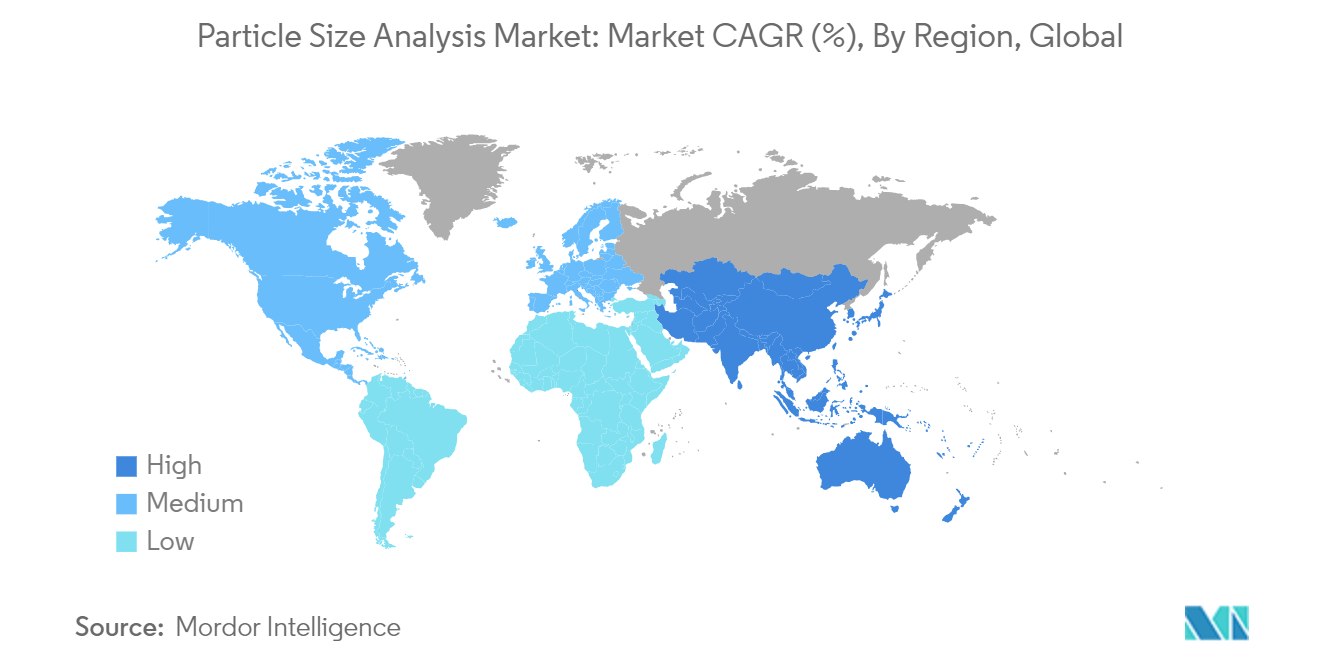Market Trends of Particle Size Analysis Industry
Pharmaceuticals Industry to be Largest End User
- Particle size is a critical parameter in the pharmaceutical industry, as it affects surface area and porosity, thereby impacting a drug's bioavailability, effectiveness, and shelf life. Consequently, particle size is monitored in quality control and the development of new active pharmaceutical ingredients (APIs).
- Particle size distribution (PSD) is one of the most important parameters to evaluate when assessing new drugs. For example, particle size is essential for powder inhalers used in treating various lung diseases, as it ensures the effective delivery of the API in powder form to the lungs. The drug is prepared as a powder and inhaled without any propellant gas. The API may be applied in its pure form or adhered to a carrier material, such as lactose.
- The particle size analysis market is experiencing significant growth, driven by the escalating demand for pharmaceutical products. Several critical factors contribute to this expansion, including the rising spending power of consumers, the enhancement of health infrastructure, advancements in diagnostic technologies, and the increased accessibility of pharmaceutical products. According to IQVIA (Midas Quantum) data, US pharmaceutical sales in 2023 were projected to reach approximately USD 678 billion, and global pharmaceutical sales in 2023 were projected to reach approximately USD 1.607 trillion, underscoring the robust growth trajectory of the sector.
- The growth of the pharmaceutical industry in emerging countries also creates a favorable outlook for developing the market. For instance, in recent years, India has emerged as the leading provider of generic medicines, occupying about 20% of the global market share.
- According to Invest India, the country is the world's largest vaccine manufacturer. As particle size analysis is crucial in pharmaceutical manufacturing, as off-spec particle sizes can lower yields, impede production, and ultimately reduce profits, the growing pharmaceutical sales are anticipated to positively impact the market's growth.
- Leading pharmaceutical companies allocate substantial capital to R&D, advanced technologies, and strategic alliances. These investments drive the particle size analysis market's growth and innovation.
- In 2023, Merck & Co. led the industry in R&D spending, significantly outpacing its competitors. Merck & Co. allocated 50.79% of its budget to R&D, partly driven by classifying its USD 10.3 billion Prometheus acquisition as R&D expenditure. In comparison, Roche Pharmaceuticals, Novartis, and Lilly also demonstrated firm R&D commitments, with their ratios ranging from 27% to 30%. Such investments are anticipated to continue to drive the market's growth further.

Asia-Pacific to Register Major Growth
- This region is one of the fastest-growing markets for particle size analysis. The emergence of different new techniques in determining the size of particles and size distribution and growing new industrial applications, especially pharmaceuticals, are expected to boost the market of particle size analyzers in the region.
- The chemical industry holds a significant share of the particle size analysis market, and its expansion drives the demand for particle size analysis. With the region's increasing chemical production, precise control over particle size becomes essential. Particle size directly impacts a chemical's properties, performance, and reactivity.
- For example, catalysts in chemical reactions often depend on specific particle sizes for optimal efficiency. Using particle size analysis techniques, chemical manufacturers can ensure they produce materials with the desired characteristics. This results in better product quality, optimized reaction yields, and the potential development of innovative new chemicals. The growing emphasis on precision and control within the Asian chemical industry will continue to propel the demand for advanced particle size analysis equipment and techniques.
- The region is leading the advancement of nano-sensor technology. South Korea holds the second-highest nanotechnology patents, followed by Japan, China, and Taiwan. This increase in nanotechnology patents is expected to augment market growth, necessitating particle sizing analysis for the tracking of nanoparticles.
- Various semiconductor components are manufactured with the help of particle size analyzers. The region offers a tremendous opportunity for growth. With a large base of untapped markets, such as Vietnam, Indonesia, and India, as well as vast raw material reserves and a leading market for underground mining operations, the region is emerging as one of the biggest markets for mining activity. Australia is one of the largest markets for mining innovation. The strong demand for innovation in the mining sector and continual government support are expected further to develop the market opportunity for particle size analysis.


